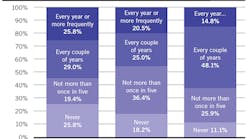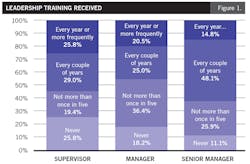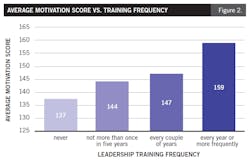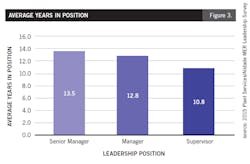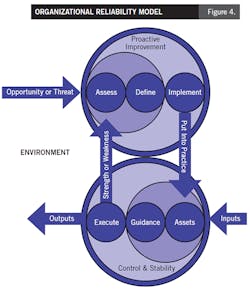Most major change initiatives fail. Some sources estimate that 70% don’t achieve their expected return on investment (ROI). That’s because the projects are laid on top of an underlying foundation that cannot support the changes. It’s like having a house built on ground that can’t support its weight. The money and time expended to build the floor, walls, ceilings, and roof and then add interior finishes and furnishings are wasted when the foundation sinks and the structure fails.
After spending decades in leadership positions diagnosing organizations and reading case studies, I’ve concluded that the majority of organizational issues are rooted in three fundamental problems that permeate every aspect of performance. If these issues are not dealt with, every iteration of change management – including enterprise software upgrades, industrial internet of things (IIoT) initiatives, etc. – will have difficulty producing a positive return on investment.
Problem 1 – Accountability
The problem for many organizations is a lack of accountability between senior leaders and subordinate leaders. Large organizations can have as many as five to seven organizational levels. At each organizational level, there is a senior leader and a subordinate leader. There is a binary or reciprocal accountability that must be maintained with each set of senior and subordinate leaders.
Senior leaders are accountable for providing direction, guidance, and assets (resources) to enable subordinate leaders to execute or perform their responsibilities. Direction includes mission, vision, values, and objectives. Guidance includes policies, plans, processes, procedures, and measures. Assets are the people, funding, facilities, equipment, tools, software, information, etc., that are needed to carry out guidance. The senior leader delegates responsibility for executing on objectives to subordinate leaders.
Subordinate leaders are accountable for efficiently and effectively leading their teams using the direction, guidance, and assets provided and for notifying senior leaders if direction, guidance, or assets are deficient in some way. Senior leaders are then accountable for revising direction, guidance, and assets.
As an example of failed accountability, a client with which I worked had a stated objective of the plant being in the top 10 among its industry peers. This was critical to the organization’s objective to attract and retain top researchers and other workforce members and to ensure high customer and shareholder satisfaction. Yet senior leaders provided funding for only 55% of the staffing level needed to achieve a high level of performance. The compensation (wages and benefits) provided to workers was more than 15% below the average for the region. That resulted in more than 22% turnover.
Subordinate leaders did the best they could, but they were not enabled to execute on the plant objective. Nor were they accountable for effectively challenging senior leaders to get what they needed – to put the onus on senior leaders to address the deficiencies. Senior leaders had several alternatives:
- Keep direction, guidance, and assets as currently provided and expect something to change (Einstein’s definition of insanity).
- Improve guidance and increase assets (through staffing and compensation) to enable achieving the stated objective and reaching the desired level of performance.
- Reduce the direction and performance expectations to match what is achievable with the guidance and assets provided.
After introducing an organizational reliability model, this client chose Option 2: increasing compensation and the number of authorized persons in the workforce. The organization gradually made these changes over two to three years because that’s the rate at which it could increase compensation and because it took two to three years to get all guidance and asset requirements identified and implemented. That organization is now on the right path.
Problem 2 – Not enough good leaders
For the record, I do not believe in born leaders. After studying contemporary brain science, I believe a person’s leadership potential or ability stems from the things that person has experienced and how deeply those experiences are driven into the person’s long-term memory.
Because of the way our brains function, we as humans have the ability to learn throughout our lives. If to this point in your life you have not experienced the things needed to attain the knowledge, tools, and skills to be a productive leader, you can still learn them. However, to learn, you must also have the desire to learn and the willingness to expend effort studying and experiencing the things that will help you become a productive leader.
Some people arrive at an organization with great leadership skills. They may have learned these through time in the military or by having worked for an organization that invested in their leadership capability. Sometimes a person had good mentors earlier in his or her career. Your organization may have great leaders by the luck of the draw or because someone recognized great leaders and was able to bring them aboard.
In many organizations, supervisors and managers are selected based on their tenure or because they seem to be good at getting things done. Often, a person who might be a better candidate will decline such a position. They see the additional administrative burdens, relationship changes, or loss of overtime pay as not worth it. Sometimes a prospective leader simply lacks confidence in his or her leadership knowledge and skills. The organization ends up with a less-qualified person for the position.
There needs to be a model that defines what the organization expects of its leaders. The model must be anchored by:
- Direction from senior leaders (mission, vision, values and objectives),
- Guidance (policies, plans, processes, procedures and measures), and
- Assets (personnel, tools, equipment, software, etc.) needed to carry out that guidance.
These anchors are the things that senior leaders must provide from the accountability discussion in Problem 1. Assuming that direction, guidance and assets are all sufficient, the model must define the leadership aspects that leaders are accountable for demonstrating, including:
- The desire to be a leader. A person in a leadership position needs to be responsible and have a personal set of missions, visions, values, and objectives.
- Knowledge of leadership roles, attributes, and skills. Leadership roles include expert/technician, manager/administrator, coach, systems thinker, and visionary. Leadership attributes include being consistent, attentive, respectful, motivational, and assertive (CARMA). Leadership skills include time management, communication, empowerment, the ability to effectively give and receive feedback, and conflict resolution.
- Understanding of sources of power and how power is enhanced or degraded. Position power is formal power that is delegated downward from a senior leader to a subordinate leader. Personal power is earned from all other persons based on how the leader interacts with others.
- An understanding of needs theories and how to influence the behaviors of subordinates, peers, and senior persons. People’s behaviors are based on their motivations, and motivations are based on needs.
- The ability to set goals that drive teams toward achieving organizational and functional objectives. Creating goals that allow teams to experience “wins” on the way to achieving their objectives creates positive energy. It is also critical for team members to know that their leaders are engaged, attentive, and assertive.
Instituting a productive leadership model creates clear standards for training and evaluating current and prospective leaders. In cases where demonstrated leadership ability is lacking, there will be an established set of leadership knowledge, tools, and skills, and classroom training, on-the-job training, and coaching can be used to help close gaps.
Knowing what knowledge, tools, and skills will be required also creates the opportunity to solve a third problem: leadership development and sustainability.
Problem 3 – Leadership development and sustainability
Here’s a common scenario: The plant manager knows there’s a problem with leadership. Policies and procedures aren’t followed; turnover is too high; grievances are increasing; and safety incidents are on the rise. So, the plant manager asks the human resources (HR) director to find some leadership training.
The HR director identifies several training firms and asks them to submit proposals. The contractor that has the best combination of the glossiest brochure and the lowest cost is selected. A dozen supervisors and junior managers attend the workshop.
After the training, the attendees are asked how it went. A couple them report it was great training and they’re appreciative of the opportunity to learn. A couple of others grumble that it was a waste of time. The rest feel like it was good information but are skeptical that they will be able to apply what they learned. The attendees go back to work.
Morale among the workforce improves temporarily, but only because workers are making jokes about the managers and supervisors who attended the training. The workforce has seen it before. They expect no real changes, and they are right.
This is what I call a one-and-done leadership training event. It is characterized by the recognition that something needs to be done followed by an insufficient response. Why do one-and-done leadership training events fail to make a difference?
- Senior leaders and subordinate leaders don’t have reciprocal accountabilities (Problem 1).
- The leadership training content changes with the training provider. There is no consistency to the terminology or specific subjects covered because the required knowledge, tools, and skills have not been defined in a productive leadership policy.
- Senior leaders do not ensure that the leadership knowledge, tools, and skills provided to the training attendees are actually applied. Without using or practicing the knowledge, tools, and skills, only 10% to 20% of the training memories are retained.
- When leadership training is infrequent and/or inconsistent, there is no peer-to-peer or senior-to-subordinate socialization to create a productive leadership culture.
A few years ago, the Plant Services/Alidade MER Leadership Survey asked participants how often they received leadership training. Figure 1 shows the Leadership Training Received by Leadership Level graph. Note that:
- 26% of supervisors and 18% of managers indicated they had never received leadership training.
- 19% of supervisors and 36% of managers said they received leadership training not more than once in five years.
Survey responses also showed a direct correlation between frequency of participation in leadership training and reported motivation levels. Figure 2 shows motivation scores versus leadership training frequency. The average motivation score for supervisors, managers, and senior managers was 146.8; above-average motivation scores were found when training happened annually or not less than every two to three years. Below-average motivation scores occurred when leadership training never took place or took place no more than once every five years.
Among respondents to the Plant Services/Alidade MER survey, the average supervisor had been in his or her position for 10.8 years, and the average manager had been in his or her role 12.8 years (see Figure 3). Those are long periods of time for 45% of supervisors and 54% of managers who received inadequate leadership training and who had low motivation to be leading teams.
What productive leadership looks like
A Productive Leadership System© includes the Organizational Reliability Model©, the Productive Leadership Model©, and the Productive Leadership Development Program.
Organizational reliability is the accountability framework within which productive leadership can be supported. As shown in Figure 4, organizational direction is communicated by the organization’s mission, vision, values, and objectives. The organization’s direction is a North Star by which it can assess and define new requirements or modifications to current requirements. The organization’s direction should be stable and should not change drastically over short periods of time. Direction can change when there is a strategic response needed due to external opportunities or threats or internal strengths and weaknesses.
When strengths, weaknesses, opportunities, or threats (SWOTs) are identified, they are assessed, and requirement changes are defined based on the organization’s stated direction. Requirements are the guidance and assets authorized by senior leaders. When implemented properly, guidance and asset requirements avoid or minimize ambiguities, gaps, and overlaps. Ambiguities, gaps, and overlaps indicate a lack of control over assets, and there is no way to identify when not enough or too many assets are available to carry out guidance.
- Ambiguities occur when guidance is unclear. This often takes the form of vague descriptions of roles and responsibilities, knowledge, tools, skills, assets, measures, etc.
- Gaps occur when guidance does not cover important aspects of the role or task – especially those that pertain to quantity of personnel and their capabilities, training, tools, software, funding for contractors, etc.
- Overlaps occur when there are two or more forms of guidance that state or imply that the same role or responsibility has been given to two or more persons or entities or assets are committed to two or more activities.
As subordinate leaders execute, they generate data. Data helps subordinate leaders identify strengths and weaknesses. They are accountable for notifying their senior leader if there are discrepancies in direction, guidance, assets, or inputs. Senior leaders must resolve discrepancies.
The Productive Leadership Model (see Figure 5) is a standardized set of knowledge, tools and skills supported by accountability, and it necessitates that the leader be provided with organizational direction, sufficient guidance, and sufficient assets. These are anchor points from which the leader can be accountable for executing. Productive leaders who follow the model will understand:
- What they need to know about themselves: their desire to be a leader, their willingness to take responsibility, and their own mission, vision, values and objectives.
- Key leadership roles and attributes needed for success.
- Their sources of power, which source to use and when, and how to enhance their power.
- Needs theories, to better understand the needs and motivations of others – this will allow the leader to influence others to achieve objectives.
- How to create goals that align with organizational direction and lead toward achieving objectives.
The goal of the Productive Leadership Development Program is to initiate and sustain the Productive Leadership System. The program includes:
- A productive-leadership policy communicating that productive leadership will be the leadership system for the organization. This should be signed by the highest authority in the organization.
- Establishment of baseline and periodic measurement, given that the best way to measure productive leadership is to link leaders with their direct-report team members using a team effectiveness and motivation survey (TEMS)
- A Productive Leadership System© training program. All leaders and prospective or candidate leaders should get standardized initial and recurring training on organizational reliability and productive leadership. Initial training provides orientation and expectations. Refresher training should be for one-half to one-third of the leaders every year. Training a portion of the leadership team every year increases socialization of the subject matter. Further, be sure to include productive leadership performance in position descriptions, annual evaluations, and leadership position selection criteria.
The bottom line is that you can’t expect subordinate leaders to perform if they are not provided with what they need to be successful. Control and stability of day-to-day performance and change management through proactive improvement will fail if organizational reliability and productive leadership are not in place.
